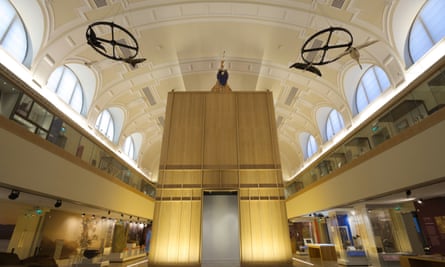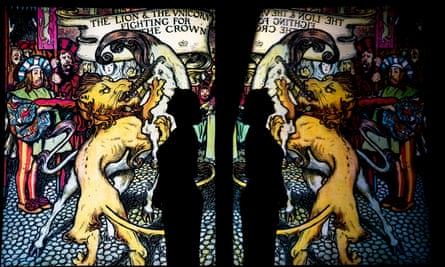It takes balls to transform a local collection of archaeology, art and stuffed salmon into a museum with ambitions on an international scale. And it so happens that balls are one of the new Perth Museum’s highlights, albeit prehistoric stone ones. Decorated with nodules large and small, these carved rocky spheres were a speciality of neolithic artists in Scotland. What do they mean? Nobody knows, but their carefully designed patterns evidently meant a lot to the people who lived in what is now called Scotland about 5,000 years ago.

A stone can say so much. Even a blank one. Compared with these intricately hewn prehistoric artefacts, the stone that is the centrepiece of this museum is visually dull indeed – but it is enlivened by a spectacular setting. The museum has been fashioned out of an old Edwardian city hall with an imposing classical exterior and a huge, galleried central chamber. Right in the middle rises a tall wooden tower inside which, after a dramatic build-up in a darkened antechamber, you are admitted to see Scotland’s Stone of Destiny.
How much symbolism can one large flattish block of sandstone carry? So much, it seems. The Stone of Scone, as it’s also known, was recently placed under the throne in Westminster Abbey for Charles III’s coronation. It has been part of the ritual of Westminster coronations ever since Edward I’s forces took it south as war booty in 1296.
The Stone of Destiny’s destiny, it turns out, is to return to Perth. For the city is just a few miles from the ruined Abbey of Scone where, until the English looting, Scottish medieval kings were crowned in the sacred presence of this symbolic block. When you enter its presence, an immersive animated video puts you in Scone graveyard to witness the coronation of the boy king Alexander III in 1249.
This atmospheric presentation is a fascinating insight into how an object can acquire and keep rich accretions of meaning. But creating meaning, as this lively museum crowded with wood and rock and dried fish demonstrates, is simply what humans do. About 3,000 years ago the ancient inhabitants of Scotland took a whole oak tree and hollowed out its trunk to make a boat that sailed on the Tay. Why? To catch salmon, suggests a Pictish megalith nearby, from around a millennium later, with an acutely observed salmon carved into it.
The Picts may also have gone into battle naked, if a standing stone discovered in 2017 during roadworks by Perth Crematorium is anything to go by. A nearly lifesized naked warrior is carved into it, his bum round and prominent as he goes into battle with spear and club. His clothes may have been painted over the nude carving, suggests the caption, but it’s more fun to picture the Picts running naked towards their enemies.

This museum takes you so intimately into ancient Scotland that I half-expected to see the Eagle of the Ninth from Rosemary Sutcliff’s famous novel. In fact there are Roman military inscriptions and even a sculpture of a Romano-Celtic deity that show the empire’s explorations beyond the wall. There are also bronze Roman vessels used by the early Scots for feasting, obtained in war or trade.
There are no written sources to explain what the Picts were thinking when they carved a hunk of rock with four cartoon faces, or what it meant when bronze age people threw swords into the River Tay. Yet their legend persists, long after the names of the Pictish gods who demanded such tribute have been forgotten. So it’s appropriate that the museum’s opening exhibition, staged partly on the upper floors of its wooden tower, investigates Scotland’s mythic heraldic beast, the unicorn.

The royal arms of the Renaissance King James V show two rampant unicorns, a device later merged into the British crown’s lion and unicorn. Yet there is more here than nationalist heraldry or today’s LGBTQ+ adoption of the unicorn. There are gorgeous medieval manuscripts with paintings of this magical creature, a print by Albrecht Dürer of a wild man mounted on a unicorn abducting a naked woman, a fantastic flower-bedecked tapestry with a unicorn in its natural habitat. Narwhal tusks in the exhibition were treasured because they were thought to be unicorn horns. A Tudor amulet contains precious life-preserving “unicorn horn”.
In a 16th-century painting by Luca Longhi, lent from the Vatican, a young woman sits in the countryside pointing to her pet unicorn that sits docilely by her. It symbolises her chastity and also her strength as it does obeisance to her. Longhi’s painting derives from drawings by Leonardo da Vinci as you can tell from the Leonardesque mountains in the blue distance.
This is a local museum that reinvents local museums. Its collection has been built up by Perth since the 1700s and has all the fun of a cabinet of curiosities. It makes you realise we all come from wonderlands. Nature and history are great resources of inspiration that can be excavated everywhere, but all too many towns and cities wear their past with dulled embarrassment. Perth shows how there are magical mystery tours to be had in every place.
Perth Museum, Scotland, opens 30 March

Comments (…)
Sign in or create your Guardian account to join the discussion